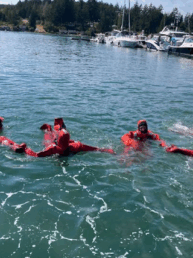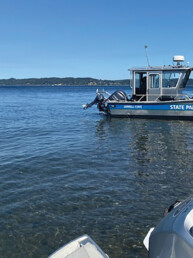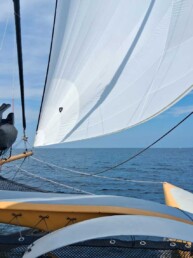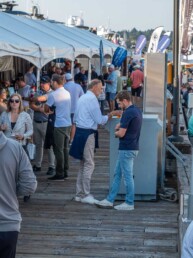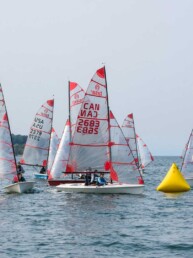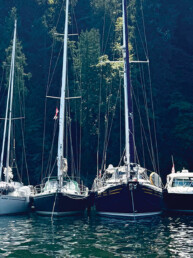International One Design Interest Builds in the San Juan Islands
A cold day in the winter of 2003 found Michael Douglas in Mystic, Connecticut. He’d traveled across the country to inspect an old International One Design called Nutmeg (Hull No. 19) intent on bringing her back home to Orcas Island.
The International One Design’s story began in 1935, not far from Mystic on the waters of Long Island Sound. Cornelius Shields—then the commodore of the New York Yacht Club and an uncannily talented class racer—was keen on finding a bigger, faster replacement for the 29-foot Sound Interclubs they had been campaigning. He envisioned a true one-design boat, one on which all of the major variables would be equalized so skippers would be measured on skill, not on how much they spent on improvements.
Racing in Bermuda that summer, he found his inspiration in a newly delivered Six Meter-class boat named Saga, which had been designed and built by Bjarne Aas in Norway. Years later he recounted, “The minute I saw Saga, I fell in love with her. I thought she was the most beautiful boat I’d ever seen. I loved her shape, her sheer, her dainty transom, and her long, straight counter… It was terrible. All I could think of on the way back to the States were the lines of that darned boat.”
Shields reached out to Aas to commission a design for a somewhat smaller boat with a cabin, based on the 37 ½-foot Saga’s lines (Six Meter was a formula-based class designation, not a measure of length). After some back- and-forth during the winter of that year, the design was fixed. She would measure 33-feet 5-inches overall with a 6-foot 9-inch beam. Her waterline length would be 21-feet 5-inches. She’d carry 466 sq. ft. of sail and displace 7,120 lbs., 4,100 lbs. of which would be ballast.
The English designer and sailor Uffa Fox described the boat’s lines “as clean as a smelt’s… each and every [one] perfect for its purpose.” One imagines that Shields had little trouble enlisting a few of his friends to form a syndicate to underwrite the cost of the first 25 boats.
By December of 1936, the first four arrived on the East Coast. Shields christened his boat Aileen. She was in the water by Christmas. Excitement flashed across Long Island Sound when the initial boats exceeded all performance expectations. By the summer of 1937, the entire first run of 25 boats, Nutmeg among them, was racing on the Sound. The International One Design Class was born.
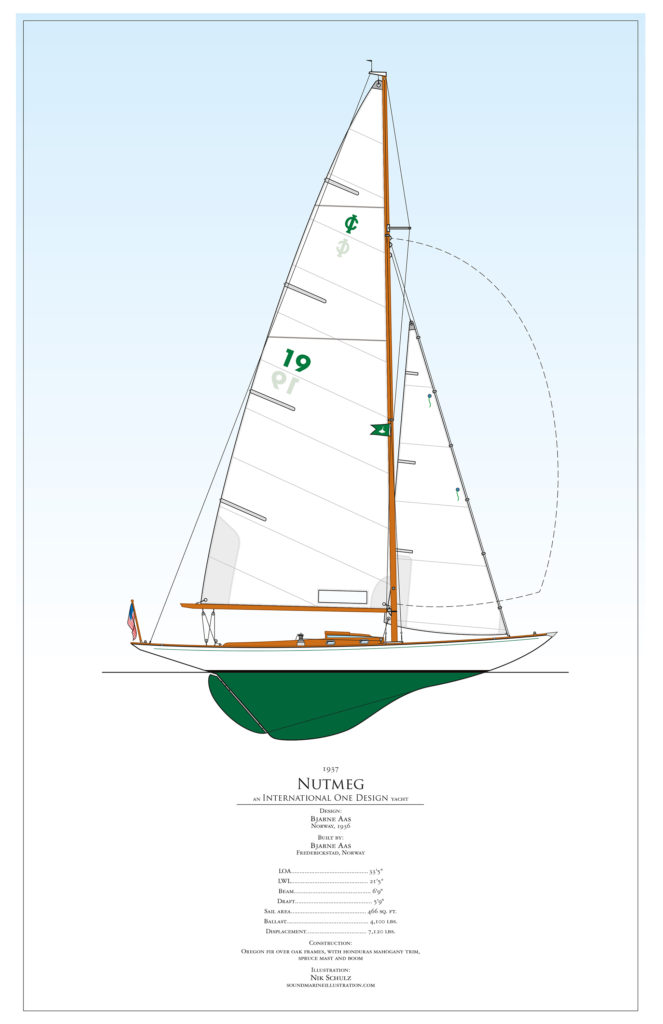 Returning to more recent history, Nutmeg did pass inspection that day in 2003 and Mike spent the winter back home on Orcas figuring out how to get her to the West Coast. Set on transporting the boat himself, he sought quotes from local shops to have a trailer built but they wanted a list of specs and measurements that he didn’t have. So he called a shop in Connecticut. “What do you want it for?” they asked. “To tow an IOD,” he said. “OK—no problem.” came the response.
Returning to more recent history, Nutmeg did pass inspection that day in 2003 and Mike spent the winter back home on Orcas figuring out how to get her to the West Coast. Set on transporting the boat himself, he sought quotes from local shops to have a trailer built but they wanted a list of specs and measurements that he didn’t have. So he called a shop in Connecticut. “What do you want it for?” they asked. “To tow an IOD,” he said. “OK—no problem.” came the response.
Soon the trailer was ready, and by the spring of 2004 Mike and his two adult children were heading west, driving 24 hours a day with Nutmeg in tow. Late one night, on his off-driving shift, Mike woke up in the back seat to hear his daughter say, “Oh no you don’t!” She was going head-to-head with another truck trying to pass her while towing a powerboat as they both went full-steam up the Continental Divide.
Between 1936 and 1970 nearly 300 wooden One-Designs were built by Aas in Norway. Of these, and the later fiberglass boats, approximately 150 still race in a dozen clubs around the world. A heavy concentration of boats can be found on the East Coast. A sole West Coast racing fleet exists in San Francisco. But that doesn’t mean it’s the only fleet out here.
Of the boats that no longer race, some end up being collected, restored, and maintained by interested owners like those in the Wooden Boat Society of the San Juan Islands (WBSSJI). Mike, who is the president of the Society, has spearheaded the effort to bring a total of four IODs to the San Juans: Quickstep (Hull No. 88), Ariel (Hull No. 85), Flirt (Hull No. 80), and, of course, Nutmeg (Hull No. 19). Here, the scene is more about cruising than racing. As Mike likes to say, “We sail with each other rather than against each other.”
That said, there are a few races on the WBSSJI calendar: The Yellow Island Wooden Boat Race in May, the Deer Harbor Rendezvous Wooden Boat Race in September (canceled this year), and the Round the County race in November.
Three of the four boats in the San Juans came from San Francisco. A fifth SF-to-San Juans boat, Prophet (Hull No. 81) was rebuilt on the islands by Mike and a group of friends over five years; but when no local buyer could be found, she was sold to an owner back in the Bay Area.
I asked Mike about the enduring appeal of his IOD, which is now 83 years old. “They feel like an old Sparkman & Stephens boat.” he said. IODs carry more than 50-percent of their weight in their keels and have relatively tall rigs (though in some areas the mast heights were changed to better suit local conditions). He said they will heel over to dip the rail at 23-degrees or so and then just stay there. No reefing is needed. The helm, he reports, is incredibly well-balanced. If he walks up the deck on the leeward side, she’ll head up. If he walks up on the windward side, she’ll fall off. He says the boat rides through the water not over it like a light glass boat. “She’s not affected by chop—she’ll just drive straight through. A lighter boat will accelerate faster but slow down faster as well.”
Having been designed for the light airs on Long Island Sound, she gets on equally well in the light airs of the San Juan Islands. Getting around without the wind, however, can be a challenge since all IODs were originally supplied without engines. Incredibly though, Mike reports, a 3 hp outboard will push the boat along at 6 knots. Simplicity. It’s all part of the joy of owning a vintage thoroughbred.
If you’re interested in an IOD, Undine (Hull No. 83) in San Francisco is currently for sale. For information contact Danielle Lawson at danielleames@gmail.com.
Mike still has that IOD trailer and will make it available to anyone interested in bringing an IOD north from the Bay Area. Contact him at mikedouglas@rockisland.com.
To learn more about the International One Design class, read “The Saga of the International One-Design” available at https://sites.google.com/site/iodwca/home/iod-book.
Nik Schulz
Nik Schulz is an award-winning, internationally published illustrator whose work has appeared Wired, Fortune, Road & Track, among many others. He also enjoys drawing sailboats and is available for private commissions. Reach him at nik@soundmarineillustration.com

